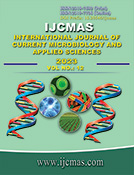


 National Academy of Agricultural Sciences (NAAS)
National Academy of Agricultural Sciences (NAAS)

|
PRINT ISSN : 2319-7692
Online ISSN : 2319-7706 Issues : 12 per year Publisher : Excellent Publishers Email : editorijcmas@gmail.com / submit@ijcmas.com Editor-in-chief: Dr.M.Prakash Index Copernicus ICV 2018: 95.39 NAAS RATING 2020: 5.38 |
Due to climate change and dwindling water supplies, precise irrigation methods are essential. Remote Sensing is a tool that can be used to determine crop coefficients indirectly. The research area included three wheat-growing districts in North Maharashtra. The purpose of present work was to assess the applicability of remotely sensed Vegetation Indices (VIs) for modelling spatial crop coefficients, choose the most relevant vegetation index among them for modelling and apply this model to predict wheat water requirements. Sentinel 2A, MIS sensor images were employed to produce NDVI, NDWI, SAVI, MSAVI2 and RVI multi temporal vegetation indices. The week-wise VIs was linked with the week-wise crop coefficients of wheat suggested by MPKV, Rahuri and establishing linear models. All of the vegetative indices have a relatively good correlation with wheat crop coefficients with considerably high R2 values. However, the NDWI-Kc model has the highest R2 value of 0.954 and the lowest SE, RMSE, and PD values of 0.0796, 0.0748, and 3.14.The RVI-Kc model performed poorly with R2 value of 0.703.Estimated total crop evapotranspiration of wheat for Dhule was found 449.65 mm whereas for Jalgaon it was 440.92 mm and total crop evapotranspiration of wheat for Nashik was found 429.16 mm.
 |
 |
 |
 |
 |